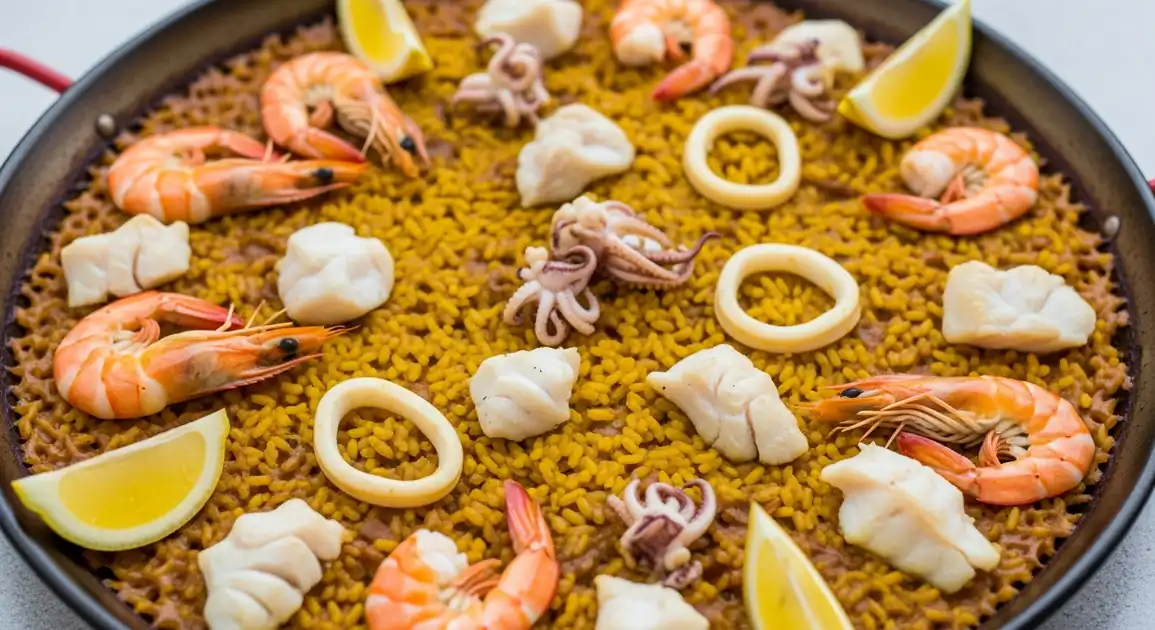Arroz del Senyoret (Gentleman's Rice)
Arròs del Senyoret (Valencian) / Arroz del Señorito (Spanish)

Description
Arroz del Senyoret is primarily a specialty of the Valencian Community (Valencia, Alicante, Castellón). While some restaurants specializing in Valencian cuisine might offer it in other parts of Spain (like Madrid or Barcelona), it is far less common than traditional paella outside its home region. Its heartland is the Valencian coast.
Dietary Information
Serving information
Serving style
Served hot in the paella pan it was cooked in, placed in the center of the table for diners to serve themselves or onto individual plates. Often garnished with lemon wedges.
Quick facts
Lunch focused: 1 PM - 4 PM. Dinner service: 8 PM - 11 PM.
Safety Tips
What to Look For
-
Served freshly cooked and hot
Rice dishes should be cooked to order and served hot to ensure safety and quality.
-
Fresh smelling and tasting seafood
Shrimp, squid, and fish should smell clean and taste fresh, with no hint of ammonia or 'off' flavors.
-
Reputable 'Arrocería' or Restaurant
Choose establishments known for their rice dishes and good hygiene standards.
-
Properly cooked rice
Rice should be cooked through ('al dente' or slightly softer is common) but not mushy.
What to avoid
-
Seafood that smells or tastes bad
Strong indication of spoilage; do not eat.
-
Dishes served lukewarm
Increases risk, indicates it wasn't freshly prepared or held correctly.
-
Establishments with poor cleanliness
Increases risk of cross-contamination.
-
Mushy or undercooked rice
Indicates poor preparation, though less of a direct safety issue than spoiled seafood.
Price information
Price range
Budget tips
- Prices are typically charged per person, with a minimum order of two people often required.
- Expect to pay around 15-25 EUR per person in most Valencian restaurants.
- Prices are higher in prime tourist locations or upscale restaurants.
- It's generally priced similarly to seafood paella.
Value indicators
- Authentic preparation with all seafood peeled/boneless.
- Use of quality saffron and flavorful broth.
- Presence of 'socarrat'.
- Served hot in a proper paella pan.
Where to Find This Dish
Valencian Community Restaurants
Widely available in restaurants ('arrocerías') throughout Valencia, Alicante, and Castellón provinces.
Coastal towns, Inland towns known for rice
Lunch
Specialty Valencian Restaurants Elsewhere
Found occasionally in restaurants focusing on Valencian cuisine in major Spanish cities.
Madrid, Barcelona (specific venues)
Lunch, Dinner
Vendor Tips
- Specify 'Arroz del Senyoret' or 'Arroz del Señorito' clearly to distinguish it from other paellas/rice dishes.
- Confirm the minimum order size (usually 2 people).
- Allow ample time for preparation (20-30 minutes minimum).
- Ask about the 'socarrat' if you enjoy the crispy bottom layer.
How to Order
Regional Variations
-
Specific Seafood Used
(Marisco Específico)
The exact types of white fish (monkfish, hake, cod) or squid (calamar, sepia) can vary based on availability and restaurant choice.
-
Broth Intensity
(Intensidad del Caldo)
The richness and depth of the seafood broth ('fumet') can differ significantly between restaurants.
-
Presence/Amount of Socarrat
(Presencia/Cantidad de Socarrat)
Achieving the desired crispy bottom layer ('socarrat') varies; some restaurants excel at it more than others.
-
Related Dish: Arroz a Banda
(Arròs a Banda)
Very similar flavor base, but traditionally the rice (cooked in fish broth) is served separately *after* the fish and potatoes used to make the broth have been eaten.
Cultural context
History
Legend attributes the dish's creation to Valencian restaurants catering to impatient or 'lazy' upper-class diners ('señoritos') who didn't want the hassle of peeling shrimp or de-boning fish at the table. It evolved as a variation of 'Arroz a Banda' (rice cooked separately in fish broth, served after the fish) or Seafood Paella, prioritizing convenience while retaining the deep seafood flavors derived from a potent broth made using the shells and fish bones that are later discarded.
Local significance
Represents Valencian rice culture and culinary refinement. The name reflects a playful nod to convenience and perhaps social status.
Eating customs
- Sharing the pan amongst the table is common.
- Using lemon sparingly to enhance, not dominate, the seafood flavor.